Click here to access my summary of learning video for EDTC 300.
Thanks for a great semester & wishing you a wonderful summer!
"The influence of a good teacher can never be erased" - Unknown
Click here to access my summary of learning video for EDTC 300.
Thanks for a great semester & wishing you a wonderful summer!
Wow! It feels surreal to be writing my last learning project post for EDTC 300! It has definitely been quite the adventure learning how to knit from online sources only! The experience came with many moments of frustration but at the same time, many moments of pride for what I learned and what I accomplished. I enjoyed the opportunity to chose what I wanted to learn, the ability to guide my own learning journey and the opportunity to foster my creativity along the way! I want to send a huge THANK YOU to all of my fellow classmates who made this experience a great one! All your comments and words of encouragement as I went along was greatly appreciated! When I think back to the beginning of the semester, I never would of guessed that I’d be enjoying blogging so much (I was very hesitant at the beginning) or that I would have broken away from my comfort zone in so many ways – from expanding my skills beyond creating simple washcloths to becoming comfortable creating videos and everything in between.
Now lets take a look back and see how the various weekly learnings played out. Below is a breakdown of the learning project weeks and all I have accomplished.
Week One – The Knitting Chronicles
Week Two – Welp, Here Goes Nothing

Photo by Canva
Week Three – TikTok Here I Come
Week Four – From Knits to Purls
Week Five – There is an App for That
Week Six – Continental vs. English Knitting. Say What?!?
Week Seven – Mistake Rib Stitch : Who Said Mistakes Aren’t Possible?!?
Week Eight – Expanding my Repertoire with Nimble Needles
Week Nine – My First Cup Cozy
Week Ten – One Bubble Stitch at a Time
What I Learned from My Experience of Learning from Online Sources
Final Thought
I will miss our EDTC 300 community, but I am sure our paths will cross again in future classes or maybe even in my future school placements! Thanks for following along and contributing to my learning journey! Have a great summer!
I will admit, that when we were first told we had to comment on our classmates’ blog posts every week, I didn’t see much value in this task. I thought it was just going to be a task to get done. However, quickly into the semester I started to see the great value of it and I looked forward to commenting every week. To me the comments helped to build a sense of community, helped to build connections and helped to feel like I was less alone in the struggles or anxieties I was facing while blogging/doing the learning projects. Also, as a bonus I got to learn from my classmates! When I was commenting on my classmates blog posts, I strived to write thoughtful and encouraging comments. As I know there was times when my classmate’s’ positive comments on my posts, helped to motivate me and encouraged me to continue to expand outside my comfort zone.
In regard to our group Discord chat, I would say that I have contributed and helped out a few of my classmates. We have an extremely supportive group who was quick and happy to respond to each others’ questions. There were often times that I was too slow getting to the chat and the questions were already answered. It was great to see the teamwork and willingness to help from everyone.
As for the visual showing of my interactions with my peers through Discord and Blog Comments, I have created a slideshow that is linked here.
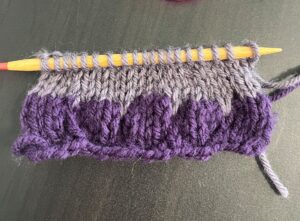 Hello EDTC 300! We are at week 10 of my knitting journey! Wow time has flown! This week I decided to have some fun with learning the ‘Bubble Stitch’. I figured to add an extra layer of learning and to make my Bubble Stitch more interesting that I would also learn how to knit in a second colour of yarn. I really enjoyed learning this stitch and I am happy with the final product. I can see myself using the Bubble Stitch and both variations of the purple yarn I used in the future to create another cup cozy.
Hello EDTC 300! We are at week 10 of my knitting journey! Wow time has flown! This week I decided to have some fun with learning the ‘Bubble Stitch’. I figured to add an extra layer of learning and to make my Bubble Stitch more interesting that I would also learn how to knit in a second colour of yarn. I really enjoyed learning this stitch and I am happy with the final product. I can see myself using the Bubble Stitch and both variations of the purple yarn I used in the future to create another cup cozy.
For this project I used 6 mm curricular needles, but I didn’t knit in the round, I just used them to knit back and forth, like you do with straight needles. I have found the curricular needles to be easier to maneuver since they aren’t as long as straight needles. I used two different colours of yarn this time, I used a light purple and a dark purple. They are both medium weight acrylic yarn.
The Bubble Stitch
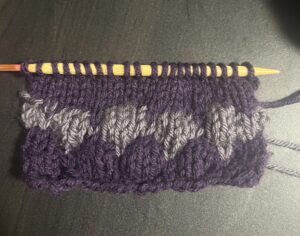 The source I was learning from this week was Kristen with Studio Knit videos on YouTube. I learned the Bubble Stitch is created by using mostly knit and purl stitches, which I am very familiar with by this point but it also included another technique I hadn’t learned yet. The technique is called ‘Knit 4 Below’, this is what creates the bubble look in the stitches. In order to create this, you have to drop 1 stitch from the left needle, then pull apart your needles to allow for the yarn in between to stretch. You have to then drop 4 stitches down to create 4 ‘ladders’ (straight lines of yarn). The next step is to pickup the stitch below these ladders with your right needle, then put your needle in behind the 4 ‘ladders’. Wrap your working yarn around the top of this same needle (right needle) and pull the yarn through all the layers and knit into the stitch below. It sounds confusing and I was nervous the first few times as it seems unnatural to purposely pull the stitches apart, but once you do it a few times, it becomes more straightforward. For this process I found Kristen to be relatively easy to learn from. Below I will list some of the things I appreciate about learning from her video:
The source I was learning from this week was Kristen with Studio Knit videos on YouTube. I learned the Bubble Stitch is created by using mostly knit and purl stitches, which I am very familiar with by this point but it also included another technique I hadn’t learned yet. The technique is called ‘Knit 4 Below’, this is what creates the bubble look in the stitches. In order to create this, you have to drop 1 stitch from the left needle, then pull apart your needles to allow for the yarn in between to stretch. You have to then drop 4 stitches down to create 4 ‘ladders’ (straight lines of yarn). The next step is to pickup the stitch below these ladders with your right needle, then put your needle in behind the 4 ‘ladders’. Wrap your working yarn around the top of this same needle (right needle) and pull the yarn through all the layers and knit into the stitch below. It sounds confusing and I was nervous the first few times as it seems unnatural to purposely pull the stitches apart, but once you do it a few times, it becomes more straightforward. For this process I found Kristen to be relatively easy to learn from. Below I will list some of the things I appreciate about learning from her video:
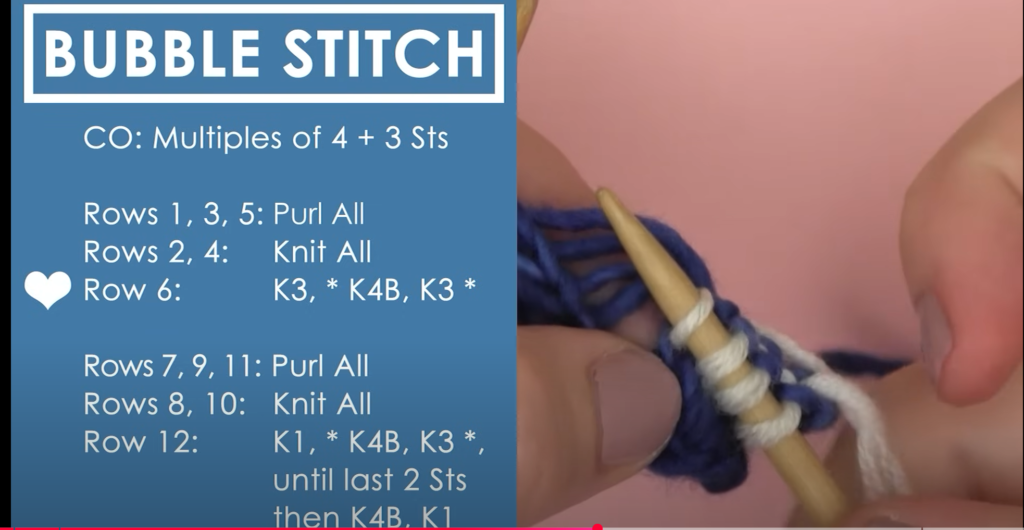
Studio Knit Video displaying pattern and teaching the technique at the same time
I ended up viewing her other video that was linked in her comment section for how to change yarn colours in knitting and I found it equally as easy to learn from. I will definitely be adding Studio Knit to my list of sources to learn from again in the future!
Thanks for following along for another week of Amber’s Knitting Chronicles!
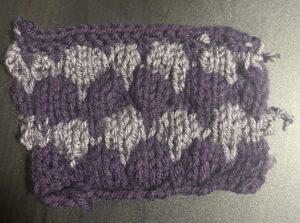
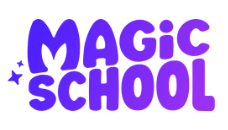 For this weeks blog post, I have decided to explore the AI tool, MagicSchool. I had heard about this tool quite a bit but never explored it myself, until now. I was blown away by all features it had, including MagicStudent, which allows students to use a similar but alternate platform.
For this weeks blog post, I have decided to explore the AI tool, MagicSchool. I had heard about this tool quite a bit but never explored it myself, until now. I was blown away by all features it had, including MagicStudent, which allows students to use a similar but alternate platform.
Features of MagicSchool
There are so many resources to help teachers generate ideas using AI tools. Below is a list of features that stood out to me and that I explored:
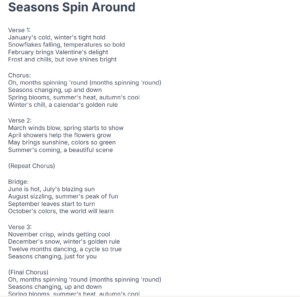
Song Generated about the Seasons, Weather and Months of the Year
Can create a song around any topic you would like and have to ability to prompt AI with specific words or ideas you want included in the song.
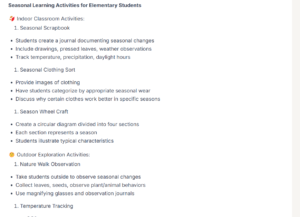
Learning Activity Suggestions Based off themes from the Song “Seasons Spin Around”
And the list goes on and on…
MagicStudent
As I briefly mentioned before, MagicStudent is a student friendly platform that is attached to MagicSchool. I watched this video that gives an overview of the functions of MagicSchool, from this I learned the following: This platform lets you, as a teacher, create rooms for your students to join that include different AI tools that your students can explore and use. The teacher can allow the students access to the room by sharing a link, sharing a QR code or by sharing directly to Google Classroom. The teacher has the ability to chose which AI tools they want their students to have access to. Also, as a teacher you can view all the interactions students have with the tools available on MagicStudent. This allows you to see if the interactions and work being done are appropriate and following the procotols that are have been taught.
Basically, MagicSchool creates a safe and structured environment for students to gain experience working with AI tools. Additionally, it opens the opportunity to have conversations with your students around responsible AI use and allow the students to put that into practice. I believe that is a way more beneficial approach then banning or blocking AI use completely from the classroom. As we have talked about lots in our EDTC lectures, educating appropriate use of technology is way more helpful to students than banning it all together. Also, as Katia mentioned in class, if allowing AI use in the classroom or for assignments, just make sure to have clear policies around what is acceptable and what is not.
AI Use For the Classroom
I understand that as a future educator you have to respect and follow the policies in place at your school around the use of AI tools for both educators and students. I also understand that there sometimes is controversy around the ethical practice of teachers using AI tools for lesson plans, etc. Additionally, I can see a challenge being that maybe not all teachers will use a critical lens when reviewing the suggestions on MagicSchool and this could potentially lead to bias or stereotypes being enhanced in the classroom learning environment. However, I believe a lot of these tools are beneficial for teachers and helps create opportunities for time well spent focusing on the students. Teachers still have to do the groundwork around figuring out the specific knowledge needing to be taught and they have to use prompts to feed this specific information into MagicSchool. Also, teachers shouldn’t just blindly accept the suggestions given, it is important to make sure to review the suggestions through a critical lens (looking for bias and appropriateness of information) before implementing (this is explicitly stated when creating a MagicSchool account) . I feel this tool helps teachers to brainstorm and helps them with ideas to make their material more engaging and effective. It also cuts down on some of the tasks that sometimes take away valuable time. As a result, from using MagicSchool for these tasks, the additional time saved, can be used towards other important aspects of the teachers’ role, such as building stronger relationships and further assisting students with their learning. Lastly, as technology continues to rapidly improve and change, I believe AI use in the classroom will no longer be a question. It will just naturally be an integrated aspect of education. Therefore, I feel it is best to embrace it now while it is still our choice.
Welcome back to another week of Amber’s Knitting Chronicles! This week I decided to learn how to knit in the round using circular needles in order to make a cup cozy. I chose to learn from this tutorial video by Mikaela Martens. I would say that this week I definitely experienced a learning curve and my final product wasn’t as good as I had hoped for. However, mistakes are an important part of the learning process and I truly believe they deepen our understanding.
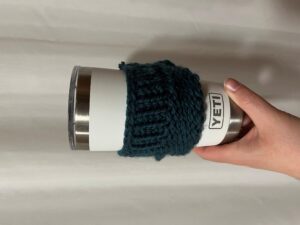 For this project I used 8 mm curricular knitting needles and a super bulky acrylic yarn. I found that as I was working in the round, I noticed I started to have a better understanding by the end and that my movements seemed to come more naturally too. Unfortunately, I was so focused on my project that I completely forgot to take any pictures of my process to document the concept of knitting in the round. But I am happy to share with you pictures of my flawed final product! You will notice that the cup cozy is half Stockinette Stitches and half Purl Stitches. That wasn’t supposed to happen, the outside is supposed to be all Stockinette and the inside all Purl Stitches. I believe that my stitches got twisted halfway through my work and resulted in me accidentally flipping my work. Therefore, when I continued my knitting I was then knitting on the wrong side. However, I will say that amidst the imperfections I am still very proud of my first cup cozy and I look forward to creating more in the future. I plan to work on improving my techniques while trying out different designs.
For this project I used 8 mm curricular knitting needles and a super bulky acrylic yarn. I found that as I was working in the round, I noticed I started to have a better understanding by the end and that my movements seemed to come more naturally too. Unfortunately, I was so focused on my project that I completely forgot to take any pictures of my process to document the concept of knitting in the round. But I am happy to share with you pictures of my flawed final product! You will notice that the cup cozy is half Stockinette Stitches and half Purl Stitches. That wasn’t supposed to happen, the outside is supposed to be all Stockinette and the inside all Purl Stitches. I believe that my stitches got twisted halfway through my work and resulted in me accidentally flipping my work. Therefore, when I continued my knitting I was then knitting on the wrong side. However, I will say that amidst the imperfections I am still very proud of my first cup cozy and I look forward to creating more in the future. I plan to work on improving my techniques while trying out different designs.
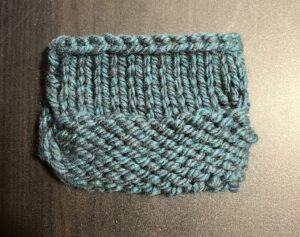
Learning from Mikaela
I found Mikaela’s video to be a great fit for me to learn from overall. It is hard to exactly pinpoint what made it a great video to learn from but I believe sometimes you just easily connect with a person’s explanation style. Although, I will say I noticed many similarities to the other sources I have enjoyed learning from. This was seen in the way Mikaela walked you through the steps at a slow enough pace to follow along, she repeated the steps multiple times and she shared general knitting knowledge that as a beginner I greatly appreciate. Also, below the video, in the comments, Mikaela shared a link to the written pattern that you could follow along to. I enjoy when sources include these alternative/additional learning resources. A few noteworthy things I learned from Mikaela is:

8 mm Curricular Needles
Tips for My Next Attempt
After I finished my cup cozy, I did some extra research for ideas on how to improve on my next attempt.
Thanks for following along for another week of my knitting journey!
I will admit when I found out we were going to be learning about coding this week I wasn’t very interested and was looking forward to getting it over with. I didn’t have much prior exposure to coding. It is an area that I generally lack interest in and kind of assumed that a lot of it wouldn’t make sense to me. However, by the end of this week I am finding value in teaching coding to my future students, and I even had some fun along the way!
Music Lab Jam Session
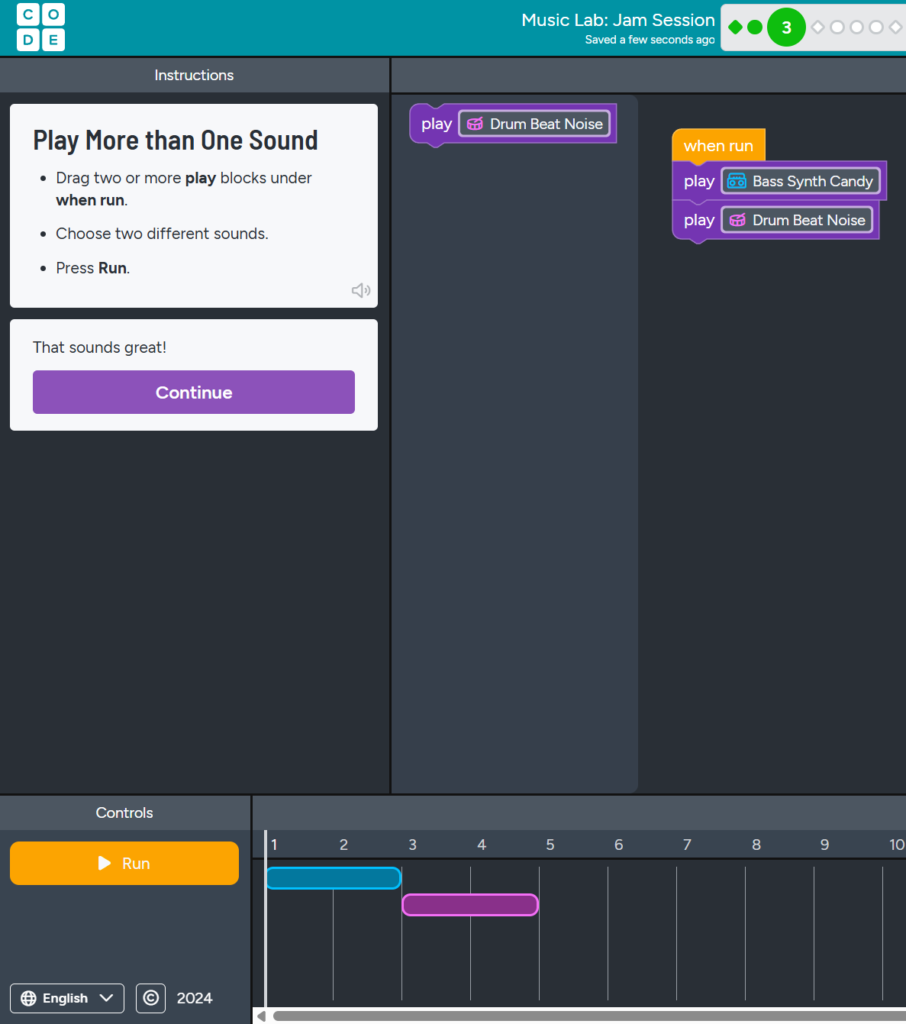 I chose to explore the Hour of Code options on Code.org. I then chose the Music Lab Jam Session since the idea of working with music sparked my interest. I begun this session with a less than enthusiastic attitude and I ended the session feeling the exact opposite. I had a great time exploring the different coding tools it introduced to me and felt like there would be great benefit for having my future students explore and learn from Hour of Code activities, specifically this one. A few things I found useful and appreciated about the Music Lab Jam Session are:
I chose to explore the Hour of Code options on Code.org. I then chose the Music Lab Jam Session since the idea of working with music sparked my interest. I begun this session with a less than enthusiastic attitude and I ended the session feeling the exact opposite. I had a great time exploring the different coding tools it introduced to me and felt like there would be great benefit for having my future students explore and learn from Hour of Code activities, specifically this one. A few things I found useful and appreciated about the Music Lab Jam Session are:
Since Music Lab Jam Session is particularly interactive and reliant on sound I knew that describing my experience wouldn’t be the same unless I was able to create a video with sound. Enjoy!
Importance of Teaching Coding in the Classroom
As our society develops towards a more digitalized world, knowing how to code is going to be an extremely beneficial skill for our students as they grow up and begin entering the workforce, as this will be a valued skill employees will be looking for in the future job market. However, regardless of that factor, coding has many benefits in the learning process for our students now. As explained in an article about the importance of coding, the benefits of teaching children to code are the teaching of:
As we have learned in previous weeks in regards to digital citizenship, specifically digital literacy (fake news, disinformation), it is more important than ever for us to teach our students critical thinking and problem solving. That is going to be more beneficial to them throughout their life, than learning to memorize facts. This is another great rationale for why coding is an important activity to incorporate into my future classroom.
 Mass media has created the opportunity for anyone online to potentially become a ‘News Reporter’. One cannot simply believe everything they read online. You can easily type your opinion into Google and many ‘articles’ will appear that support your opinion. However, it doesn’t mean they are all factual and they mostly only help to further deepen one’s biases. This combined with the advancement of technology, specifically DeepFakes, means we are no longer living in a society where “seeing is believing”. This makes it increasingly difficult to spot fake news stories. Even if we see or hear something on the internet, we still need to use critical thinking and not just blindly accept it for the truth. The problem lies in that a lot of the fake news and disinformation out there is being accepted as the truth, largely due to a lack of education around fake news, but also due to the fact that there is so much fake news being thrown at us constantly. This means that our critical thinking gets exhausted and we are more likely to let our guards down. This is why it is extremely important to educate both ourselves and our students in digital literacy in order to combat the spread of fake news. Once again, knowledge is key to combating disinformation!
Mass media has created the opportunity for anyone online to potentially become a ‘News Reporter’. One cannot simply believe everything they read online. You can easily type your opinion into Google and many ‘articles’ will appear that support your opinion. However, it doesn’t mean they are all factual and they mostly only help to further deepen one’s biases. This combined with the advancement of technology, specifically DeepFakes, means we are no longer living in a society where “seeing is believing”. This makes it increasingly difficult to spot fake news stories. Even if we see or hear something on the internet, we still need to use critical thinking and not just blindly accept it for the truth. The problem lies in that a lot of the fake news and disinformation out there is being accepted as the truth, largely due to a lack of education around fake news, but also due to the fact that there is so much fake news being thrown at us constantly. This means that our critical thinking gets exhausted and we are more likely to let our guards down. This is why it is extremely important to educate both ourselves and our students in digital literacy in order to combat the spread of fake news. Once again, knowledge is key to combating disinformation!
Digital Literacy in the Classroom
I believe an important part of teaching digital literacy is teaching my students to have a critical lens around the information they are reading or viewing online. Although, in order for this to happen, I must first discuss with them and make sure they understand that biases exist in the relaying of information. As there is no such thing as objectivity when it comes to the news.
Below are some examples from an EdCanNetwork article that I believe will be beneficial to use while teaching digital literacy to my future students:
I figured it was time I had taken my knitting skills and knowledge I have learned thus far and apply them to a project that pushes my comfort zone (only a little bit though) beyond the realm of knitted dishcloths. I came across a pattern that intrigued me for a knitted coaster. Also, since I am new to following patterns I appreciated the easy to follow language used in this particular pattern. In the article, Norman even explains that this coaster pattern is great for helping people practice their stitching technique and form.
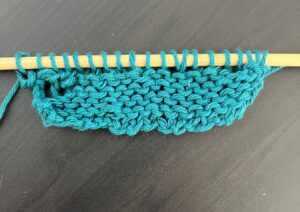
Cotton Yarn
The pattern recommended using a cotton yarn since it is more “absorbent and durable” than other types of yarn which makes it ideal for coasters. So I went out and bought some cotton yarn to give it a try. I was interested in trying a different type of yarn since I have only used acrylic thus far. I decided to do a basic ‘Stocking Stitch’ with the cotton yarn to get myself used to it before attempting the pattern. Although, this didn’t go as well as I was hoping. In my previous weeks of learning I had read that the finer the yarn the harder it is to control . I found that to be very accurate! The cotton yarn was labeled as medium weight but was definitely thinner than the acrylic yarn. I also found that the cotton yarn, since it has less give to the material, it was harder to work with and easily showed the imperfections. I accepted there would be a learning curve and was up for the challenge but unfortunately the ultimate factor that swayed me to abandon the cotton yarn was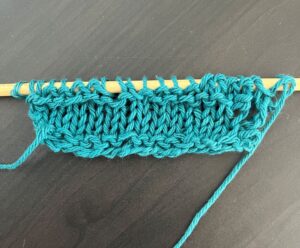 the cramps it was causing my hands. I was only able to do a few rows at best before my hands would start aching. Taking this into consideration, I made the decision to switch back to my purple acrylic yarn that is medium weight and easier on my hands to work with. In the future I will definitely try working with cotton yarn again but will maybe try a bulky cotton yarn instead.
the cramps it was causing my hands. I was only able to do a few rows at best before my hands would start aching. Taking this into consideration, I made the decision to switch back to my purple acrylic yarn that is medium weight and easier on my hands to work with. In the future I will definitely try working with cotton yarn again but will maybe try a bulky cotton yarn instead.
My Review
I found the pattern to be easy to follow and was mostly just a mixture of knit and purl stitches. I used knit stitches to create the border which is considered a ‘Garter Stitch’. I then used a combination of knit and purl stitches to create the ‘Stocking Stitch’ in the middle section. All my previous learning and practice from previous weeks came together and helped me tremendously while creating my coaster. Here are a few things I appreciated about learning from Nimble Needles:
The only thing this source was lacking was a video explanation, although considering the simplicity of the pattern and my previous experience with knit and purl stitch I didn’t find it detrimental to my learning at all.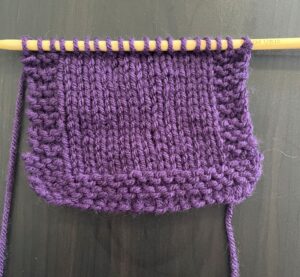
Overall, this week’s learning was probably the smoothest I have experienced thus far in my knitting journey. My coaster definitely has some imperfections, as is expected from a beginner project, but I am really proud with how it turned out and I will only improve from here. I greatly enjoyed learning from Nimble Needles and will be using him as a source in the future again.
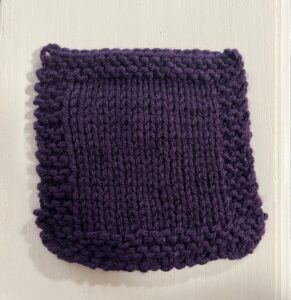
My Knitted Coaster
Cybersleuthing An Educator

Photo by Peggy_Marco on Pixabay
This week I chose to cybersleuth a close friend of mine who happens to be an educator.
Things that came up about Megan while doing a search:
If I didn’t know Megan and was basing my judgement solely on her digital identity. I would say that she is a person who throughout the years has shown a passion for teaching and a drive for learning. I would say she maintains a professional persona and as an employer I would definitely be wanting to interview her for a position as I feel she would be a great asset to any team! On the flip side, if I was a parent looking for information on my child’s teacher, I would have great confidence in her based on her digital footprint.
Digital Identity

Photo by Anemone123 on Pixabay
When discussing our digital identity, I think an important thing to acknowledge and understand is that our online identity long outlives us. Our identity online is permanent and doesn’t go away when peoples’ memories fade. This can be a positive or a negative viewpoint depending on the story your online identity tells about you. In the case of my friend Megan, her digital identity showcases nothing but favourable information about her. However, for some people that is not always the case. This week when I was watching the TED Talk by Monica Lewinsky, it took me a few minutes in to realize who she was. Sure throughout my lifetime I have heard jokes made at her expense but outside the context of the Bill Clinton scandal I never knew much about her. I didn’t know her last name, I didn’t know what she looked like and I knew nothing about her true character. All I knew of her was by a mistake she had made when she was in her early 20s and as Monica points out, who hasn’t made a mistake in their 20’s that they are not ashamed of? She made an error in judgement, like so many of us do, but unfortunately her mistake is out there for the whole world to know about for an infinite amount of time, generation after generation can continue to judge and ridicule. Monica goes on to discuss how our access to the online world has made it so easy for sharing of one’s personal information to the public without consent, context nor compassion. The sharing of specific information without context, consent or compassion can have detrimental impacts on one’s digital identity, which directly impacts their “real” life. Even if consent is given for sharing of information, context and intent are important factors to consider and often get left out in online spaces. For example, with Justine Sacco’s tweet that got her fired. Everyone assumed the worst, but as Jon Ronson points out in his video, what if the tweet was meant to be a joke at the expense of American society and not taken seriously. This brings in the third element Monica talked about with needing compassion. When we lack compassion, we are lacking the ability to see the intent behind words or actions and automatically assuming a character flaw. As Katia Hildebrandt mentions in her blog, “Identity, digital or otherwise, is a complex and slippery thing, and judging another person harshly without considering the full context is neither fair nor productive.” When we think about digital identity and the outcomes of cyber-vigilantism/cyber-shaming are the consequences worth the price one person has to pay in order for others to get a simple laugh in their day. Is the money made from this public humiliation worth more than another person’s life? These are important question to reflect upon.
© 2025 Amber Landels
Theme by Anders Noren — Up ↑